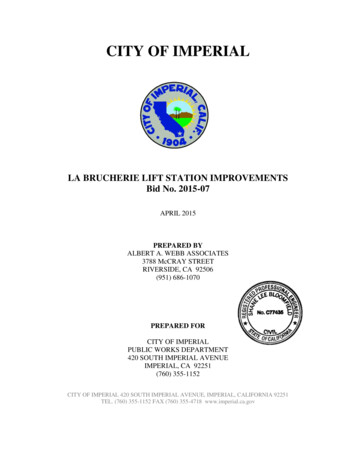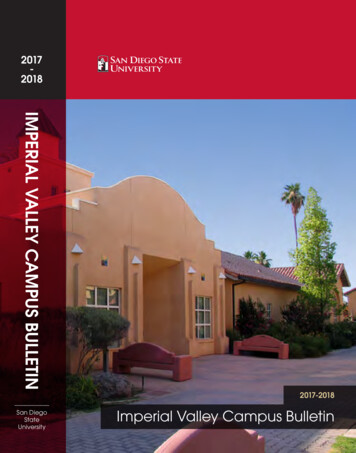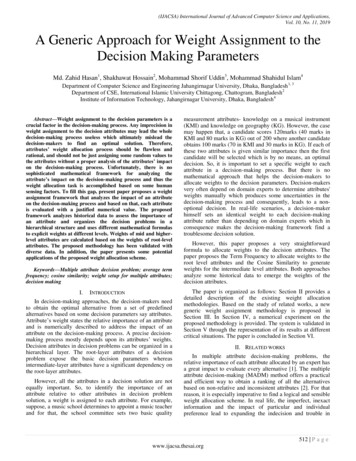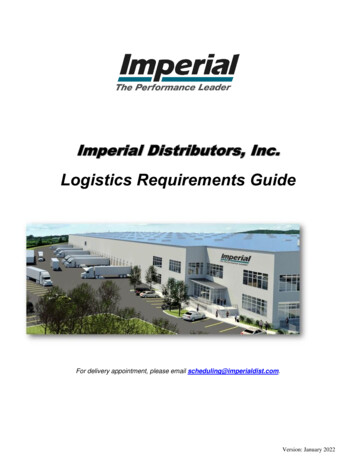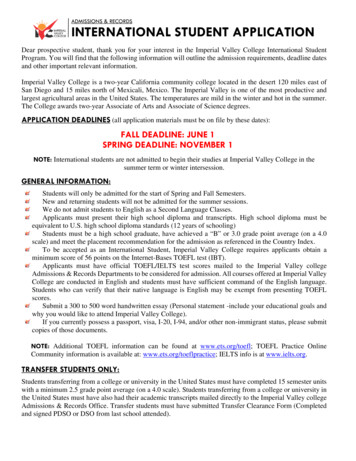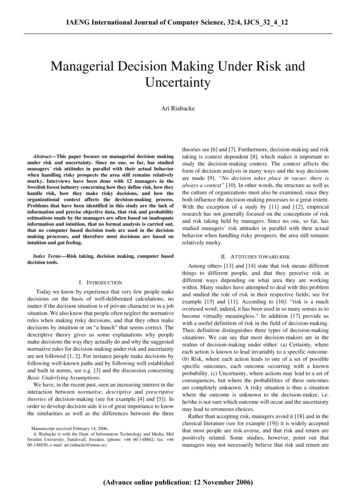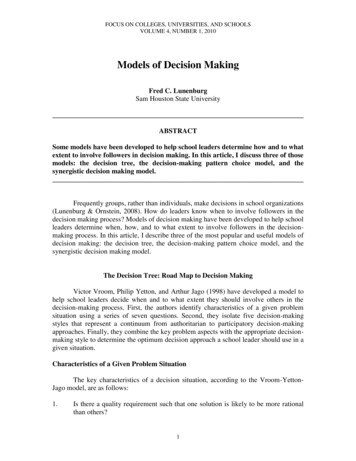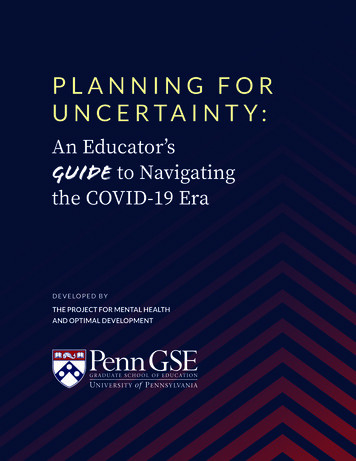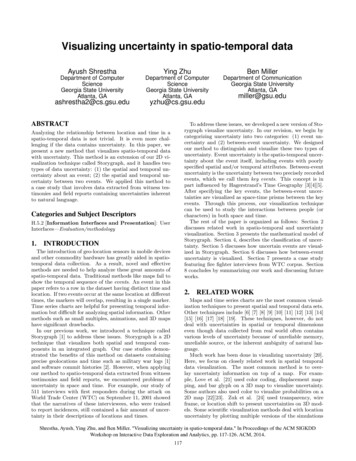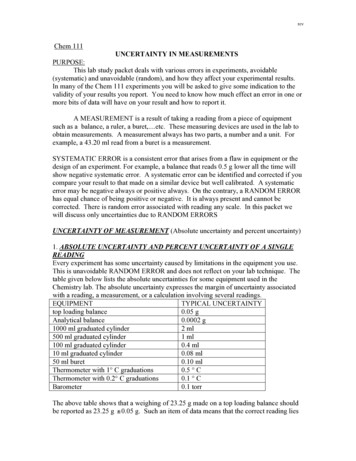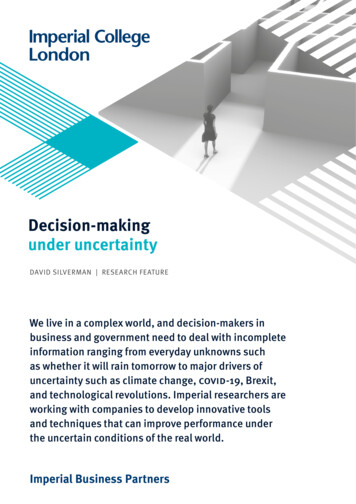
Transcription
Decision-makingunder uncertaintyDAVID SILVERMAN RESEARCH FEATUREWe live in a complex world, and decision-makers inbusiness and government need to deal with incompleteinformation ranging from everyday unknowns suchas whether it will rain tomorrow to major drivers ofuncertainty such as climate change, COVID-19, Brexit,and technological revolutions. Imperial researchers areworking with companies to develop innovative toolsand techniques that can improve performance underthe uncertain conditions of the real world.Imperial Business Partners
At Imperial College London, researchers are working withcompanies to improve decision-making under uncertainty.They are developing tools and techniques that can:» yield plans that can be easily recovered when the worlddoes not turn out as expected (e.g. in scheduling RoyalMail deliveries)Imperial College LondonBusinesses and governments often use models,optimisation algorithms and other tools in their strategicand operational decision-making to achieve goals suchas minimising costs or maximising economic and societalbenefits. However, important variables (for example, thefuture demand for a product) and the relationships thathold between them (for example, the effect of a governmentpolicy on aggregate demand) are often uncertain. A planthat should enable high performance in theory can go badlywrong when assumptions prove false, or we encounterunexpected events ranging from traffic jams to rare eventslike pandemics.Decision-making under uncertaintySummary» represent events as probabilities rather than certainties,using probability distributions to increase expectedreturns or reduce downside risk (e.g. in seed production,macroeconomic policymaking, portfolio optimisation,healthcare scheduling during the COVID-19 pandemic,and new energy systems).» support carrying out decision-making in phases(e.g. in Implementing major engineering projects).By collaborating with industry, the researchersare combining their academic expertise with thesectoral insights provided industry partners andusing this combination to create practical solutionsto real-world problems.2
Decision-making under uncertaintyBut a plan that is optimal in principle can lead to disaster when the worlddoes not behave as expected: a single traffic delay can turn a finely tuneddelivery schedule on its head, while the introduction of a new technologycan leave a multibillion-dollar engineering project redundant.Imperial College LondonMost Fortune Global 500 companies and governments, andmany smaller companies, use modelling, algorithms, andother kinds of advanced number-crunching to guide theirplanning in operations and to strategically inform policies and longterm investments. This improves performance and can bring benefitsto society.At Imperial College London, researchers in a range of disciplines are workingwith industry partners to develop techniques and technologies to improvedecision-making under uncertainty. Their solutions come in a variety ofshapes and sizes, aiming sometimes to ensure plans can be changed,sometime to guarantee positive outcomes even when they cannot beadapted, and in other cases to increase certainty over time. The researchersare pursuing real-world applications of the work in a variety of industriesand problem spaces.This article will explore some theoretical approaches to decision-makingunder uncertainty and their applications in areas that include deliveryschedules, seed production, macroeconomics and finance, healthcarescheduling during the COVID-19 pandemic, new energy systems and majorengineering projects.3
Professor Ruth Misener, an optimisation expert in Imperial’s Department ofComputing, regularly works with industry partners on optimisation underthe uncertain conditions of the real world.“Optimisation is a form of decision-making where basically you say, ‘I want todo as well as possible’, maybe ‘I want to make as much money as possible’,and you recognise that the world is full of constraints, for example, you onlyhave a certain amount of money to invest,” she explains. To make an optimaldecision, you take these constraints and parameter values such as futurecustomer demand and run them through an algorithm that tells you whichcourse of action will best achieve your objective.Chris Ratcliffe/Bloomberg via Getty ImagesOne of Professor Misener’s industry partners is the Royal Mail. In one project,Professor Misener, researcher Dr Dimitris Letsios and MSc student NatashaPage, worked with the company to help it optimise scheduling for its lastmile deliveries. A Royal Mail delivery office makes thousands of deliverieseach day, which are divided into jobs of varying lengths that each consist ofmultiple deliveries in a certain locale. The researchers were asked to developan algorithm that could determine which van should complete each job inwhich order, under the constraint that only a set number of vans can departat once. That goal was to minimise the number of vans required and themakespan (the time it takes to complete all jobs).Imperial College London“The problem,” Professor Misener continues, “is that if you don’t havean understanding embedded into your optimisation that the world is anuncertain place, then you’re probably going to get a bogus solution that isgoing to hurt you once you implement it. If you explicitly take into accountthat you’re not quite sure what’s going to happen, you can get answers thatare actually robust to things going wrong.”Decision-making under uncertaintySchedulingRoyal Mail employees sort parcelsat the company’s Mount Pleasantpostal sorting office in London.4
In the real world, however, unforeseen events like spikes or downticks indemand, staff absence, and traffic delays, make some jobs take longer thanexpected, while others are unexpectedly quick. The researchers showed thatwithout optimising for uncertainty, an on-the-day change of plan as simpleas the cancellation of a single job can turn a near-optimal schedule into onethat is dramatically suboptimal and requires substantial rescheduling torestore it to near optimum.Imperial College LondonThe algorithm they developed first calculates the minimum number of vansrequired to deliver the mail in a sufficiently short makespan, then appliesa heuristic called long-short mixing to schedule jobs, scheduling long jobson some vans in parallel to short jobs on other vans to avoid bottleneckscaused by too many vans departing at once. Referring to historical data fromthree Royal Mail delivery offices, the researchers showed that the algorithmcould have allowed the offices to carry out timely deliveries with significantlyfewer vans than they actually used, assuming they had known in advancehow long each job would take.Decision-making under uncertaintyWith hundreds of jobs to schedule and an indeterminate number of vans,the number of possible solutions is vast, and the computing time requiredto run an algorithm that could identify the mathematically optimal solutionwould be prohibitive. The researchers therefore identified heuristics (rules ofthumb) that would allow the algorithm to quickly compute a solution that isnear optimal.Professor Misener observes that major schedule changes on the day arenot practical in the fast-moving environment of a delivery office. “If you’rea postal worker, and you’re told the night before what you’re going tobe doing, you don’t want the story changed on you during the day,” shesays. “Last minute changes cause chaos and this is not really a way to leadan organisation filled with people. One of the things we aimed for in oursolution was to avoid changing the schedule too much.”Professor Misener observes that major schedulechanges on the day are not practical in the fastmoving environment of a delivery office. “If you’re apostal worker, and you’re told the night before whatyou’re going to be doing, you don’t want the storychanged on you during the day.”5
The simple reason that lexicographic optimisation works here is that itensures each van has a progressively greater capacity to take on extra jobs,meaning less busy vans are available to pick up the slack from busier onesif deliveries are delayed. More fundamentally, lexicographic optimisationmakes the schedule more robust because it adds an internal structure: ifthe first van’s deliveries are delayed, jobs are still distributed betweenthe second, third and fourth vans in a structured way that is conducive torestoring near optimality with very minimal reoptimisation on the day. In2019 the Royal Mail used the work to begin a review of its small van fleet indelivery offices across the UK.Imperial College LondonThe researchers demonstrated with reference to the historical data thatthis approach yields a plan that is not only near optimal if there are nodisturbances but can also be tweaked in response to disturbances withminimal changes while remaining relatively close to optimal.Decision-making under uncertaintyThe researchers therefore used a special optimisation technique to yieldplans that can be recovered with minimal rescheduling when they breakdown. The technique, known as lexicographic optimisation, breaks a primaryoptimisation task down into separate sub-tasks for the algorithm to carryout in a particular order of priority. In this case, they designed the algorithmto optimise the full set of jobs by minimising the makespan on the first van,such that the time the first van takes to complete its jobs must be as shortas possible and the time taken by all the other vans must be shorter still.Then, holding the makespan for the first van fixed, the algorithm reoptimisesso that the second van’s makespan is as short as possible and the othersshorter still, and repeats this for each van.Working with probabilitiesOne reason the above example of decision-making under uncertainty iselegant is that it does not require us to know the probability of unforeseenevents occurring. However, as Professor Nilay Shah, head of Imperial’sDepartment of Chemical Engineering, points out, in many contexts –in particular, those where it is not possible to build in a recovery phase– it is useful to incorporate probabilities into decision-making.“Some of the biggest things that come up are demands for products, soyou’re trying to plan some manufacturing, or you’re deciding how big afacility to build, and you just don’t know what the demand will be”, hesays. “The other thing is prices: you’re producing something that could beas simple as electricity or hydrogen and you don’t know what price you’ll get.You’re trying to make a decision about what to do given these uncertainties.”6
A better approach is to use historical data and informed guesswork toformulate a probability distribution that can be represented as a curve on agraph with newspapers demanded on one axis and a probability between 0and 1 on the other. Using this information, the vendor can then draw a curvefor each potential inventory volume (say, 100, 150 and 200 newspapers) withprobability on one axis and the other now showing overall profit or loss.Imperial College LondonBy comparing these curves, the vendor can identify the inventory volumethat will maximise their expected value (the average profit they would makeif the day were replayed an infinite number of times). It also gives them theoption of choosing a purchase volume that minimises their possible loss.This is a simple case of an approached to decision-making under uncertaintycalled stochastic optimisation.Decision-making under uncertaintyThe solution can be illustrated using a classical example from inventorymanagement. A newspaper vendor must decide how many copies topurchase each day in the face of uncertain demand, knowing that anyunsold newspapers at the day’s end will be worthless. A naïve solutionwould be to take the average number of copies sold each day and purchasethat many. However, if the cost price is 1 and the sales prices 1.50, thiswould probably be suboptimal as the cost of buying too many newspapers isgreater than the opportunity cost of buying too few.Seed productionProfessor Shah and colleagues in the Department of Chemical Engineeringapply stochastic optimisation to a variety of real-world business andengineering contexts.In one project, Professor Shah’s master’s student, Yanbin Zhu, applied thetechnique to seed production using data from seed manufacturer Syngenta.With the global population increasing, there is a greater need for moreefficient agriculture. Most of the world’s crops comes from seeds, which areoften supplied to farmers by commercial seed manufacturers. Mr Zhu andcolleagues developed a model that could allow a seed manufacturer to planseed production at regional level.The company needs to decide which seeds to plant in which regions,accounting for several variables. These include expected yield (which variesby variety, region and season), demand (which varies by variety and season)and the costs of growing, processing, and transport. Using a deterministicmodel that did not account for uncertainty, the researchers produced anoptimal plan that did better at minimising cost and land-use than a realplan provided by Syngenta and that took much less time to devise.7
Daniel Acker/Bloomberg via Getty ImagesImperial College LondonWhen they introduced a way of accounting for uncertain yields, factoringin overproduction and underproduction as costs (either in additionalproduction cost or the opportunity cost of failing to meet demand) theyfound the model considerably reduced the overall cost in situations wherethe yield was low, with a relatively small increase in cost in the event of anaverage or high yield.Decision-making under uncertaintyWith the global population increasing, there is agreater need for more efficient agriculture. Mostof the world’s crops comes from seeds, which areoften supplied to farmers by commercial seedmanufacturers. Mr Zhu and colleagues developeda model that could allow a seed manufacturer toaccount for uncertain yield, demand and costs.Bags of Syngenta AG GoldenHarvest brand hybrid seed cornsit stacked in a barn in Princeton,Illinois, US8
We are often uncertain not only about future events but also laws (forexample economic laws) that determine whether one event will followanother. Plans can go wrong not only because we fail to foresee futureevents, but also because we hold incorrect assumptions about the effectsour decisions will have.This is one kind of uncertainty addressed by Emeritus Professor Berc Rustem,leader of Imperial’s Computational Optimisation Group, which he foundedover 30 years ago, helping establish a research programme that is stillpursued at Imperial and other universities.Imperial College LondonIn the 1970s, Professor Berc Rustem began workon a research programme to advise governmenton macroeconomic policy. When Thatcher becameprime minister, she favoured monetarism over thelonger established demand-side economics. “Therewas huge controversy, and it became political which model to choose became a real problem,”says Professor Rustem.Decision-making under uncertaintyMacroeconomics and financeIn the 1970s, Professor Rustem began work on a long-running researchprogramme to optimise macroeconomic policy with control theorist ProfessorJohn Westcott, macroeconomist Professor Maurice Peston (later LordPeston) and Labour MP Dr Jeremy Bray with funding from research councils(first the ESRC and later the EPSRC). The team advised policymakers suchas parliament and HM Treasury and provided written evidence to House ofCommons Treasury Committee.At first, the group produced their own macroeconomic models – sets ofassumptions about how the economy works that could be used to help driveoptimisation algorithms. However, there was at this time increasing debateamong economists about what sort of model to adopt. When MargaretThatcher became prime minister, she favoured monetarism, which statesthat the best way to promote economic growth is by using the interest rateto regulate the money supply, over the longer-established demand-sideeconomics, which calls on the government to use spending to regulatedemand. “There was huge controversy, and it became political,” saysProfessor Rustem. “We therefore abandoned modelling ourselves andfocused on using existing models, and let that economic fight take placeamong the modellers.”9
An issue, here, is that we need to consider the kind of worst-case scenariothat happens from time to time, such as the 2008 financial crisis. If you baseyour decisions on the historical change in the value of an asset over the lastfew years, this may not help protect you against the consequences ofa sudden crash.Imperial College LondonAfter the project ended in 1991, Professor Rustem began applying relatedtechniques in chemical engineering and finance. In the latter case, he hasfocused on portfolio optimisation, the task of deciding which assets toinvest in. This, he explains, uses historical data about how assets haverisen or declined in value to optimise future returns and manage riskThe latter involves taking account of the uncertainty (e.g. standarddeviation, downside risk) gleaned from historical data.Decision-making under uncertaintyThe team began to use models produced by the London Business School,the National Institute of Economic and Social Research, and HM Treasury.“Which model to choose became a real problem,” says Professor Rustem.“When you apply your policy, assuming a monetarist model is a fairrepresentation of the economy gives you one result. If you choose anothermodel and apply your policy, you get another result. This is when we startedusing robust optimisation. What we did was to combine all these modelstogether in one framework and aimed to decide on a policy that would takeinto account all possible models and minimise the downside of choosingthe wrong model.”“Sometimes the worst case happens, and you need to be prepared for it.You can’t always assume that the worst case will happen and stop investingentirely. At the same time, you need to also think deep in the back of yourmind that the worst case can and does happen from time to time,” saysProfessor Rustem. “All this leads to robust optimisation technology thattakes into consideration worst-case events, or worst-case probabilities,in the future.”To protect against the worst-case, his portfolio optimisation algorithms makeuse of competing scenarios, analogous to the competing macroeconomicmodels built-in to his earlier work. Instead of computing the optimaloutcome under a single scenario, they compute an optimal outcomeassuming a possible range of scenarios that may come to pass, aimingto minimise the loss occurred in view of the worst case.Professor Rustem emphasises that this is not a counsel of despair againstthe possibility of understanding how future events will unfold. Using arefined version of this approach, he computes the probability distributionfor a range of scenarios, allowing, for example, a 70% probability that onemodel, or scenario, will prove correct and a 30% probability that another will.This makes it possible to reconcile trust in models with a healthy degree ofrobustness.10
While one would ideally make use of probability distributions to accountfor uncertainty whenever they are available, a key problem is that theycan be very hard to accurately compute. Wolfram Wiesemann, Professor ofOperations Research in the Imperial College Business School, specialisesin applying optimisation under uncertainty in a variety of business domains.He uses a method that allows decision-makers to benefit from probabilitydistributions while avoiding the headaches and pitfalls inherent inaccurately computing them.Second, the number of parameters that must be incorporated into a modelmakes the task computationally very challenging. The problem, known asthe curse of dimensionality, is that building a probability distribution forthe cost of manufacturing a product, for example, will require probabilitydistributions for multiple parameters (for instance the cost of labourand of various raw materials), and each additional parameter multipliesexponentially the number of future possibilities we must compute aprobability for to arrive at our probability distribution for manufacturing cost.Imperial College LondonProfessor Wiesemann says there are three major obstacles to computingaccurate probability distributions, which apply equally whether we arecalculating these distributions ourselves or using machine learning: First,the past data that decision-makers largely rely on is not always a good guideto what will happen in the future. In particular, we don’t usually have enoughhistorical data to avoid underfitting – the mistake of assuming that eventswhich happen for complex reasons have simple causes – or overfitting – themistake of assuming that events happen for reasons that are more contextspecific than they really are.Decision-making under uncertaintyUnknown probabilitiesRenewable energy is inherently uncertain. Wecan have cloudy days, in which case we have lesssun, and we may have more or less wind. That’sfundamentally different to our energy systems inthe past.Third, decision-making happens in a dynamic environment, and when weput our plan into action, we receive new data that may call into doubt theaccuracy of our original probability distributions. Professor Wiesemanngives the example of flu vaccinations: every few months, health authoritiesmust estimate which flu strains are likely to be most prevalent in the comingseason and formulate a vaccine, which takes time. The longer they wait, thebetter they know which flu strains are dominant, but the less time they haveto manufacture the vaccine, so they are forced into an uncomfortable trade-off11
Because calculating a probability distribution is very hard, and even whenwe do it prone to giving an inaccurate result, Professor Wiesemann suggestssomething quite surprising – namely that we abandon the attempt tocompute accurate probability distributions. His approach is to optimiseon the assumption that the true probability distribution differs as far asconceivable from the one modelled for. He then selects the model which, onthis basis, achieves the best possible outcome under the worst anticipatedprobability distribution. Rather than attempting to get the probabilitydistribution right, which often cannot be done, this approach minimisesthe downside risk of formulating an incorrect probability distribution.Professor Wiesemann is working with colleagues from Medicine, includingthe team led by Professor Neil Ferguson, whose work has informed theCOVID-19 policy of governments worldwide, on models to help identifythe optimal way to schedule and prioritise elective treatments during theCOVID-19 pandemic.Neil Hall/Pool/AFP via Getty Images“At the moment [January 2021], people measure governments by theirperformance on the COVID-19 pandemic. One number that people compareis how many new infections and how many people died. What we haven’tfocused on sufficiently is the number of deaths that we will have due topostponed cancer treatments and all the other treatments that will be put onhold,” says Professor Wiesemann.Clinical staff wear personalprotective equipment (PPE) as theycare for patients at the IntensiveCare unit at Royal PapworthHospital in Cambridge.Imperial College LondonHealthcare scheduling during the COVID-19 pandemicDecision-making under uncertaintybetween certainty and time. It is important for the earlier decisions to accountfor the richer information base that future decisions can be based on.12
The models they have produced categorise patients by condition (COVID19 and other conditions such as cancer) and age group and suggest howhealthcare resources should be scheduled under scarcity to minimise theyears of life lost, using Professor Wiesemann’s methods for dealing withuncertainty to allow for uncertainty about variables like patient numbers,treatment duration and prognosis.At the moment, people measure governments bytheir performance on the COVID-19 pandemic how many new infections and how many peopledied. What we haven’t focused on sufficiently is thenumber of deaths that we will have due to all theother treatments that will be put on hold,”says Professor Wiesemann.Imperial College LondonThe research has been used so far to highlight to policymakers the need tofactor in the negative impact of delaying elective treatments for conditionssuch as cancer during the UK’s healthcare emergency in winter 2020/21,where some hospitals are full and treatments temporarily rationed. Theresearch has been covered, among others, by the Daily Mail, the FinancialTimes and France24.Decision-making under uncertainty“In this project we try to take an objective approach and say we don’t careif someone comes into hospital because of cancer, because of COVID-19,whatever it is – our sole objective is to save lives, within the resources wehave.”“Fortunately, in normal times, this should not be a substantial issue withthe NHS,” says Professor Wiesemann. “If you think now about developingcountries, unfortunately this situation of resource scarcity is in some casesmore normality than an exception. We hope that our solution approachfor the pandemic will also be applicable to developing countries in nonpandemic regimes.”13
Professor Wiesemann is collaborating with another leading expertin decision-making under uncertainty, Dr Panos Parpas, Reader inComputational Optimisation, on research into new energy systems.They are part of a large project led by Professor Tim Green, Co-Directorof the Energy Futures Laboratory and funded by the EPSRC, that seeksto model and optimise the roll-out of low carbon energy systems,in particular solar and wind energy.To offset shortfalls in wind and sun, conventional energy needs to playa role in the system. But we also need to plan investments in an energysystem years ahead. Here, the problems Professor Wiesemann identifiedwith probability distributions appear: “First, we cannot form an accurateprobability distribution for wind and sun five years from now. Second isthe curse of dimensionality — we would have to keep track of wind and sunin 50 or 100 places in the UK. Third is dynamism – we’d better anticipatein our choices today that in ten years’ time we will know much more aboutdemand and the technology that will be available.” For this reason, ProfessorWiesemann does not aim to compute an accurate probability distribution.He works on identifying the plan that incurs the minimal loss should it turnout to be maximally wrong.Imperial College London“One important issue with renewable energy is that it is inherently uncertain.We can have cloudy days, in which case we have less sun, and we may havemore or less wind. So the provision of energy becomes uncertain,” saysProfessor Wiesemann. “That’s fundamentally different to our energy systemsin the past. We had nuclear, coal and gas power plants, and they worked.They needed some fault resistance, so if a power line goes down the wholeenergy network doesn’t go down, but you did not require a sophisticatedprobabilistic treatment for that. Now it’s different, suddenly uncertaintybecomes a major player.”Decision-making under uncertaintyRenewable energy14
We have seen that it is an advantage to have a plan that can be easilyadapted when unforeseen events occur, and where this is not possible, touse probability distributions to appropriately balance reward with downsiderisk. For longer-term decision-making, another valuable tool – which canbe combined with both these approaches – is to carry out a plan in phases,adapting it as more information becomes available. The key here is to buildin flexibility, the ability to adapt to a changing environment, and recognisethe right time to adapt.Dr Cardin says: “Incorporating flexibility intodecision-making when we design critical systemsis hugely important not only for maximising returnson investment, but also for making society moreresilient to extreme situations like pandemics andterror attacks. It also supports sustainability bymaking better use of resources as a whole.”Imperial College LondonDr Michel-Alexandre Cardin, a senior lecturer in the Dyson School of DesignEngineering, develops decision-making techniques for major engineeringprojects such as the building of new aerospace, building, energy andtransportation systems. These require financial investments in the millionsor billions and significant physical resources. They are also highly vulnerableto a changing natural environment, economy and technological landscape,and events like the COVID-19 pandemic.Decision-making under uncertaintyLonger term decision-makingDecision-makers sometimes tie themselves into major projects withoutbuilding in flexibility, because they are attracted by the economies of scaleachieved by committing all at once to significant investments, or they areconfident about future projections of major uncertainty drivers like priceor demand. However, recent studies have shown that building in flexibilitycan improve expected value to investors or society by 10–30% andsometimes more.Dr Cardin offers the example of the Iridium satellite phone network,which launched 66 satellites in a single year in the 90s, anticipating majordemand just as land-based mobile phone networks entered the mainstream.The unexpectedly low demand, combined with early engineering decisionsthat meant the satellites could not adjust their orbits, meant revenuefailed to cover the huge 4 billion investment – and ultimately led tothe company’s bankruptcy, despite its award-winning technology.15
Decision-making under uncertaintySTR/AFP via Getty ImagesImperial College LondonA rocket carrying the Iridiumnetwork’s first five satellites lifts offon 4 May 1997 in California.This situation could have been mitigated, Dr Cardin says, if Iridium hadadopted a flexible capacity exp
Decision-making under uncertainty We live in a complex world, and decision-makers in business and government need to deal with incomplete information ranging from everyday unknowns such as whether it will rain tomorrow to major drivers of uncertainty such as climate change, COVID-19, Brexit, and technological revolutions. Imperial researchers are
